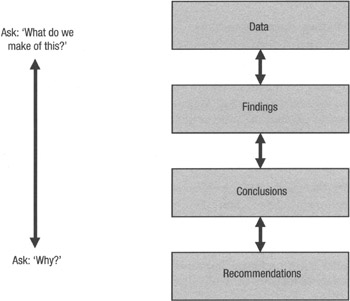DATA ANALYSIS AND CONCLUSIONS
The data collection process accumulates facts, which then have to be processed to produce conclusions. Ideally, what should have happened is that the case for or against each hypothesis should have been made. A proven hypothesis is a conclusion, and so the conclusions from a full study would be a list of the hypotheses that had been proven.
Consultancy is more expedient than science and so, sadly, rarely as rigorous as this. The whole process is a little more messy. Nonetheless, it is essential that your conclusions stand up to examination, like the layers of skin in an onion. Peeling away the top layer shows another layer as fine as the first; peeling the second layer away reveals a third, and so on. So too should it be with a consultant's thinking. For example, it is said of a former chief executive of an international firm that if you went to him with a proposal, he would take one part of your case, and ask 'Why?' of it. He would then take an aspect of your answer, and ask 'Why?' of that. He would then ask 'Why?' of an aspect of your next answer. If you could answer these three layers of questions satisfactorily, he would accept that you had thought through your case.
Three layers of thinking can be thought of in data analysis:
-
Data - the facts you have collected.
-
Findings - an evaluation of these facts. (This usually relies on unspecified data, such as a standard or normal practice.)
-
Conclusions - the diagnosis drawn from the evaluation.
The interventions that are required to address the areas of concern can then be specified according to the conclusions. Interventions are of varying kinds; frequently they consist of recommendations for the client's action, but they might also be action by the consultant, such as:
-
training client staff;
-
conducting a further project;
-
taking an executive role;
-
supporting the work of an individual or group.
For example:
-
It is raining (a piece of data).
-
The weather is bad (finding). (This is evaluative because the rain may not be bad for a farmer whose crops need rain; the unspecified piece of data is that we want the weather to be fine.)
-
We cannot go for a picnic (conclusion).
-
We should eat lunch indoors (recommendation).
Figure 6.14 shows the relationships:
-
Data lead to findings.
-
Findings draw you to conclusions.
-
The specification of the intervention(s) is based on conclusions.

Figure 6.14: From data to recommendations
Each step leads to the next by asking, 'What do we make of this, with respect to the topics we are examining?' Also, the logic can be tested in reverse by asking, 'Why - what leads us to this view?' Of course, in practice the process of splitting data, findings and conclusions under the headings shown can be a messy process. You can have difficulty sorting out what is a piece of data, a finding or a conclusion. A practical technique for dealing with this ambiguity is:
-
Divide a large piece of newsprint/flip chart paper into three columns, headed 'Data', 'Findings', 'Conclusions'.
-
Write your data, findings and conclusions on 'Post It' or similar type labels.
-
Stick them under the appropriate headings and inspect to see whether they are correctly allocated.
Use of these labels means that you can move a comment from one heading to another. A major criterion to use is that they all fit together. Once you are happy you have allocated your labels correctly, you should ask the following questions of your analysis:
-
Does the data lead logically to the findings and the findings to the conclusions? In particular, are there any alternative interpretations that could be made at any stage?
-
Are there key findings that have not been substantiated, which could be used to corroborate the conclusions?
-
Do the findings rest crucially on a narrow range of data? What would be the result if this data were inaccurate, and how inaccurate would it have to be before you changed your conclusions? How likely is it to be inaccurate? Thus the links between the various stages are tested.
There remains the final and most important test, which is to refer back to the assignment objectives:
-
Will the interventions specified satisfactorily address the areas of concern put to us? Have we met our commitments to producing outputs? Will our conclusions form a sufficient basis to move the project ahead?
The assignment objectives should be held in mind throughout the project. It is easy to stray away from the original objectives and specify interventions that, although totally logical and valid, fail to meet the client's original concerns. Remember to reread your original proposal regularly during the project.
EAN: 2147483647
Pages: 89